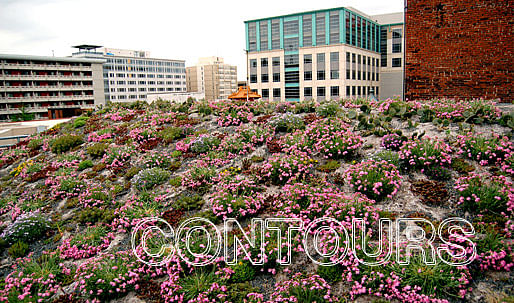

In Germany, approximately 12% of all buildings have green rooftops. Here in the U.S., the percentage is far less and in fact, that number is not even officially documented. But it is on the rise. Some more well-known examples include the California Academy of Sciences and the American Society of Landscape Architects' HQ. These are indeed admirable, but they are costly and difficult to replicate. Trying to persuade a client about the benefits of relatively inexpensive, passive, more sustainable building strategies is difficult enough and honestly a green roof is anything but.
Or is it? One of the most basic questions for architects and designers trying to persuade clients towards green roofs is what are the energy savings? Conveniently, Portland State University’s Green Building Research Laboratory or GBRL has created the Green Roof Energy Calculator. It’s absolutely free, the measuring units are either in US or international SI. What does it calculate? The energy performance of a green roof, a dark roof, and a white roof. Questions? The team that maintains the website will provide answers as best they can. That makes it that much easier to show clients actual numbers while designing a roof.
The next question is, how to design a green roof, and what are the definitions? Enter Michigan State University’s Green Roof Research Program or GRRP in the Department of Horticulture. There researchers are exploring issues including cost/benefit, viability, and strategies that can aid architects and designers on specific design approaches. Even better, these are not based on a single, anecdotal “case study”—which after all are what all those aforementioned green roof buildings are—but on systematic, university research. Thus studies on different factors control for all other variables.
The research sites include three different building roofs on campus fitted with sophisticated equipment to monitor the varying conditions being tested. Additional replicated roof conditions have been set up in numerous test beds. Each building site or test bed explores a specific issue to determine optimum outcomes that will aid the architect or designer. The results over time were and are still being systematically recorded and compared. Several different issues have been and are being investigated including plant establishment and survival, drought tolerance, soil composition and fertility, stormwater management, and even carbon sequestration.
One clear benefit of green roofs is they provide an overall carbon sink if the resultant production of these systems exceeds decomposition. This effect is called terrestrial carbon sequestration. And since more carbon dioxide is produced in urban areas vs. rural ones (where there is obviously more green space to absorb it), it would be advantageous to install green roofs on buildings in urban areas.
This depends, however, on the type of green roof. There are both extensive or intensive roofs: extensive roofs include low-growing plants such as grass, moss, and succulents. Intensive roofs include trees and shrubs, and obviously they require deeper substrates.
Next, the researchers tried to determine optimal configurations based on different factors. For instance, they discovered that the ideal green roof requires a substrate (i.e. both the plant “container” and what comprises the biological environment in which the plants grow) that is both lightweight and permanent. Why? Because not only does this provide the ideal environment for both intensive and extensive green roofs, but it also minimizes other negative effects such as leaching nutrients that are harmful to the environment. That after all would defeat the purpose of a green roof. Specifically, “high levels of substrate organic matter…will decompose…and can leach nutrients such as nitrogen (N) and phosphorus (P) in the runoff.” A related study found that an extensive roof with low-growing vegetation reduced stormwater runoff by almost 40% as compared to a conventional gravel roof (60.6% vs. 27.2%). Even roofs with just a substrate—soil but no vegetation—offered a 50% reduction in stormwater runoff.
In designing a green roof, one must address the issue of types of vegetation to install considering leaching, drought tolerance, and survival. Essentially, deeper substrates (containers and soil) could provide “additional growth [potential] with sufficient water” to encourage drought tolerance. However, this approach required additional irrigation for the vegetation. Shallower substrates, however, required more frequent irrigation. As to plants, they investigated several issues: how they established and survived over time, how resistant they were to weeds and competing plant beds, and finally, how tolerant they were to different weather conditions. They also examined what types of plants thrived in irrigated vs. non-irrigated beds. Non-irrigated roof beds required faster growing plants that could self-propagate from seed, while irrigated beds could accommodate a wider variety of native plants. For those inclined towards succulents, these could survive in shallower substrates and low-level, controlled-release fertilizer. Non-succulents required deeper substrates as well as more fertilizer and irrigation. To control leaching of nutrients from the roofs, however, fertilizer must be minimally applied to maintain the plants.
It is the goal of both the GBRL and GRRP to make it easier for architects and designers to install green roofs. These tools and research are bringing that reality closer.
Sherin Wing, Ph.D., is a social historian who writes on architecture, urbanism, racism, the economy, and epistemology (how we know what we know by researching and examining the agendas inherent in our sources of information) to name a few issues and topics. She is dedicated to exploring issues in ...
No Comments
Block this user
Are you sure you want to block this user and hide all related comments throughout the site?
Archinect
This is your first comment on Archinect. Your comment will be visible once approved.